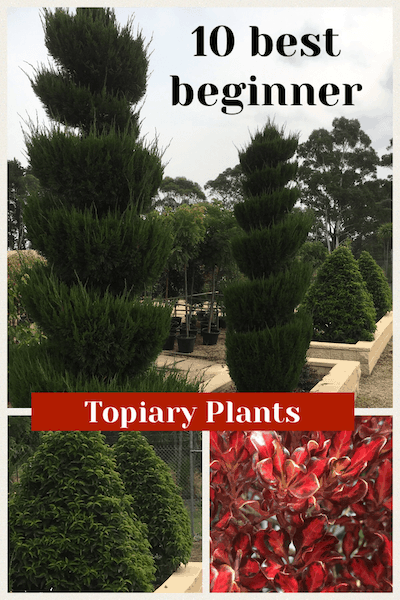
Topiary is the art of shaping plants. For beginners like us, we try and keep the shapes simple. More advanced topiary artists are capable of creating amazing works of art in any shape and size imaginable.
The plants on this list are all easy to grow and love being pruned (which is obviously super important for topiary).
Juniperus chinensis ‘spartan’- Green spartan juniper
Juniper spartan is tall growing conical conifer. It reaches a mature height of 9m (30ft).
It has a dense growth habit and it’s fast growing.
Due to the conical habit, it’s best use as a topiary specimen is as a spiral. Some people keep the top flat to create a soft green pillar like structure.
An easy plant to grow. Prefers moist, well draining soils, in full sun or part shade.
Can be pruned at any time of the year, however any major structural pruning is best done at the end of winter/ beginning of spring just before the new growth. This way any mistakes can disappear into the new growth 😉
Laurus nobilis- Bay tree
Bay trees are another fast growing tree. Mature height is 7.5m (23ft) however most are kept much smaller than this.
Bays make great topiary specimens and have the added benefit of being able to be used in cooking!
When the plant is young it tends to devote all of its energy into one main stem. For this reason its well suited to a standard topiary (this is a bare trunk with a ball shape on top).
It also makes a great hedge.
Traditionally, people placed 2 bay trees at their front gate or near the front door. One for peace and one for prosperity.
Bay trees are tough as nails! Able to withstand drought and even bushfires! They will easily tolerate your experiments with a pair of shears or a hedge trimmer, they are very forgiving 😉
Oh, and bays can easily be grown in containers, yes it’s a very versatile plant!
Buxus- Box wood
Buxus or boxwood plants come in quite a few different species. The best for topiary are English box (Buxus sempervirens), Dutch box (Buxus sempervirens suffruiticosa) and Japanese box (Buxus microphylla var japonica).
Box wood are slower growing than the previous mentioned trees. English box trees can actually reach a height of 9m (30ft)! However, this will not happen in my life time or yours. You’ll very rarely see a buxus plant taller than 2m (6-7ft).
The fastest growing buxus is the Japanese box. Slowest and smallest is the dutch box which is sometimes called dwarf english box.
Buxus is great plant to use in topiary.
Dutch box is best suited to small balls or simple shapes.
English can easily be shaped into multiple stemmed standards, twisted stem standards, spirals, cones, larger balls, basically anything your heart desires and your creative juices allow.
Japanese box is best for larger ball shapes.
Boxwood plants are easy to grow preferring moist well draining soil. They perform best in full sun in order to obtain optimum bushy habit.
Your buxus plants will benifit from annual feeding in late winter/early spring just before the new growth. It’s also important to keep the water up to them during hotter moths, especially if in pots.
Prunus lusitania- Portugese laurel
Portuguese laurels are very hardy, they love being pruned and have a dense growth habit. Their attributes make them an excellent beginner topiary plant.
Portuguese laurels reach a mature height of 5m (14ft) and a width of 3m (10ft).
Like bays trees they make a great looking standard specimen. They also can make great pillars, box shapes or balls.
Because of their larger size they can be used as a backdrop to other topiary specimens. This affect adds depth to the landscape.
Lonicera nitida- Dwarf honeysuckle
Lonicera is easily the most versatile plant for topiary on this list! It’s super tough, adores being pruned, shaped and moulded into whatever shape you could imagine.
It’s really fast growing so don’t be scared to try your most adventurous ideas on this little beauty. Only down fall is that due to its vigorous growth, regular maintenance will be needed to keep it in your chosen shape.
It has small glossy green leaves. Grows to about 3m (10ft) by 3m (10ft). I’ve seen it shaped into many weird and wonderful things.
You can buy frames that you trim around to create your desired shapes. A giraffe springs to mind for me.
The lonicera will grow through the frame, so that you can no longer see the frame. But it will provide you with a guide as to where to trim.
This really is the ultimate beginners topiary plant!
We have a propagation guide for lonicera if you’re interested in growing your own.
Luma apiculata- Chilean myrtle
Luma has a beautiful smooth trunk when it matures. For this reason any shapes created should really try to incorporate showcasing the trunk.
It’s quite often use in Japanese inspired gardens where balls are shaped at the ends of the branches. This is what’s called a cloud tree!
I’m currently in the process of attempting to train a luma into a cloud tree. It’s going to be a slow process but one I’m sure will be worth it in the long run.
Mature cloud trees in nurseries retail for hundreds, sometimes even thousands of dollars. So I’ve had to attempt my own.
Another great use of luma is the standard. I personally like the double or triple ball look. This is just a ball then trunk then another ball.
Looks really cool with the smooth trunk and small glossy green leaves.
Mature trees will grow to 15m (30ft) by 15m(30ft).
Syzygium australe- Brush cherry
Syzygium australe is my favourite lily pilly. We have our entire nursery surrounded in a syzigium hedge.
It makes a wonderful hedge, but it’s also incredibly easy to create a standard. It grows really fast and almost always likes to focus its energy into one main stem.
Occasionally you’ll find ones with a fork in the base. These ones can either remain seperate to create a cloud tree, or the stems can be intertwined to create a platted stem, which we absolutely love the look of.
Syzygiums are very forgiving of over pruning so don’t be shy to experiment. Because they are so popular as a hedge/screen plant, nurseries usually stock quite a lot of them.
This can allow you to sort through to find the type of stem that you want to work with.
We have a propagation guide for syzygium if you want to try your hand at growing your own.
Ligustrum undulatum- Box leaved privet
Box leaved privet is another fast growing plant, very happy to be pruned.
It’s not quite as versatile as lonicera and it’s trunk isn’t as pretty as luma. But it’s usually available nice and cheap.
Ligustrum is incredibly hardy, it can be cut down to the ground and will sprout again.
For this reason I’ve include it here, because you can really go to town on this plant. Experiment-stuff up- experiment again it doesn’t matter. Super forgiving and inexpensive to purchase.
The leaves are small oval shaped, slightly crinkled and green. Grows to around 2m (7ft) high and 1.5m (5ft) wide.
Ligustrum is also easy to propagate if you’re interested.
Westringia- Native Rosemary
Native rosemary (Native to Australia) this little ripper will grow anywhere but is particularly well suited to coastal gardens.
It can handle sea spray and sand conditions no problems.
We use westringia in our garden and we are no where near the coast and in heavy clay soil. So a very adaptable plant.
Theres quite a few varieties available. The main differences are flower and foliage colour.
We shape ours into spheres and balls mostly, as well as having a have lovely low hedge.
Grows really fast. An easy beginner plant, readily available and super tough!
Coprosma- Mirror plant
Coprosma is brilliant topiary plant! There are so many different colours available. I swear you could create just a garden of different coprosmas and it would look spectacular!
Coprosmas look best shaped into balls of varying sizes.
Because the stem is quite bumpy and unatttractive, it’s not well suited to a standard.
Coprosma is incredibly drought tolerant.
As I type this, I realise I might need to find an area for a coprosma garden!
I hope you’ve found some plants that you would like to try and use for your very own topiary project.
If this has been helpful consider subscribing as we will be constantly sharing things we know and learn in our nursery and in our gardens.
Happy planting 🙂
